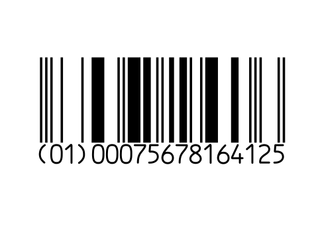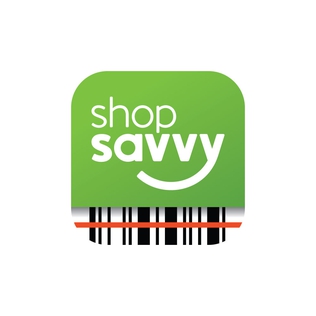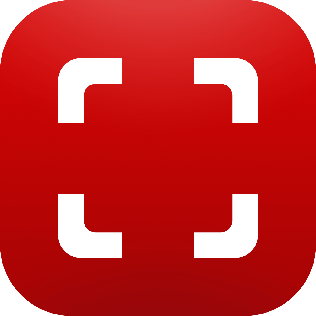
A cash register, sometimes called a till,cashbucker, or automated money handling system, is a mechanical or electronic device for registering and calculating transactions at a point of sale. It is usually attached to a drawer for storing cash and other valuables. A modern cash register is usually attached to a printer that can print out receipts for record-keeping purposes.

The Universal Product Code is a barcode symbology that is widely used worldwide for tracking trade items in stores.

A barcode or bar code is a method of representing data in a visual, machine-readable form. Initially, barcodes represented data by varying the widths, spacings and sizes of parallel lines. These barcodes, now commonly referred to as linear or one-dimensional (1D), can be scanned by special optical scanners, called barcode readers, of which there are several types.

A barcode reader or barcode scanner is an optical scanner that can read printed barcodes, decode the data contained in the barcode on a computer. Like a flatbed scanner, it consists of a light source, a lens, and a light sensor for translating optical impulses into electrical signals. Additionally, nearly all barcode readers contain decoder circuitry that can analyse the barcode's image data provided by the sensor and send the barcode's content to the scanner's output port.

The CueCat, styled :CueCat with a leading colon, is a cat-shaped handheld barcode reader that was given away free to Internet users starting in 2000 by the now-defunct Digital Convergence Corporation.

A QR code is a type of two-dimensional matrix barcode, invented in 1994, by Japanese company Denso Wave for labelling automobile parts. A QR code consists of black squares arranged in a square grid on a white background, including some fiducial markers, which can be read by an imaging device, such as a camera, and processed using Reed–Solomon error correction until the image can be appropriately interpreted. The required data are then extracted from patterns that are present in both the horizontal and the vertical components of the QR image.
The Global Trade Item Number (GTIN) is an identifier for trade items, developed by the international organization GS1. Such identifiers are used to look up product information in a database which may belong to a retailer, manufacturer, collector, researcher, or other entity. The uniqueness and universality of the identifier is useful in establishing which product in one database corresponds to which product in another database, especially across organizational boundaries.

GS1 is a not-for-profit, international organization developing and maintaining its own standards for barcodes and the corresponding issue company prefixes. The best known of these standards is the barcode, a symbol printed on products that can be scanned electronically.

Self-checkouts (SCOs), also known as assisted checkouts (ACOs) or self-service checkouts, are machines that provide a mechanism for customers to complete their own transaction from a retailer without needing a traditional staffed checkout. When using SCOs, customers scan item barcodes before paying for their total shop without needing one-to-one staff assistance. Self-checkouts are used mainly in supermarkets, although they are not uncommon in department or convenience stores. Most self-checkout areas are supervised by at least one staff member, often assisting customers process transactions, correcting prices, or otherwise providing service.
Social network advertising, also known as social media targeting, is a group of terms used to describe forms of online advertising and digital marketing focusing on social networking services. A significant aspect of this type of advertising is that advertisers can take advantage of users' demographic information, psychographics, and other data points to target their ads.

Social media marketing is the use of social media platforms and websites to promote a product or service. Although the terms e-marketing and digital marketing are still dominant in academia, social media marketing is becoming more popular for both practitioners and researchers.

The GS1 Databar Coupon code has been in use in retail industry since the mid-1980s. At first, it was a UPC with system ID 5. Since UPCs cannot hold more than 12 digits, it required another barcode to hold additional information like offer code, expiration date and household ID numbers. Therefore, the code was often extended with an additional UCC/EAN 128 barcode. EAN 13 was sometimes used instead of UPC, and because it starts with 99, it was called the EAN 99 coupon barcode, and subsequently GS1 DataBar. After more than 20 years in use, there is now a need to encode more data for complex coupons, and to accommodate longer company IDs, so the traditional coupon code has become less efficient and sometimes not usable at all.
National Consumer Panel (NCP) is a service provided by a joint venture between NielsenIQ and Circana where members in the Contiguous United States scan the barcodes on all their purchases with either a mobile app or a special barcode reader and provide additional details about their shopping purchase experience(s). The NCP program was formerly known as the Homescan Consumer Panel before the formation of the joint venture with IRI and the merger of the two companies' existing panels.
GoodGuide.Com was an online web, iPhone app and Android app tool which enabled consumers to retrieve evaluations of the health, environmental, and social impacts of consumer products such as toys, food, and detergents. GoodGuide was shut down on June 1, 2020.

The application Barcode Scanner is an Android app, from the open-source project ZXing, that allows an Android device with imaging hardware to scan barcodes or 2D barcodes and retrieve the data encoded. Information encoded often includes web addresses, geographical coordinates, and small pieces of text, in addition to commercial product codes. This Android-based system has similar functionality to a hardware barcode reader.

ShopSavvy is a mobile application for shopping that scans products and finds online and local stores providing those products. Additionally, ShopSavvy compares the prices, displays user reviews, and searches for deals and discounts on scanned items. The app was developed by Rylan Barnes, Jason Hudgins and Alexander Muse, who won the “Google’s Android Developer Challenge" and subsequently founded ShopSavvy, Inc.

Scan is a mobile app development company headquartered in Provo, Utah, United States. The company was founded in January 2011 by Garrett Gee together with his college friends Ben Turley and Kirk Ouimet. The company, owned and operated by Scan, Inc, was acquired by Snapchat in 2014 for $54 million.

Debranding is a marketing strategy to remove the manufacturers name from a product to appear less corporate, or to save on advertising. De-corporatizing is when a company removes its name from its logo for a marketing campaign in an attempt to make themselves appear less corporate and more personal. "Transitioning into generic" is when a company with a well-known brand opts to appear more generic. This means the company will eliminate advertising and reduce prices and debranding in this sense can increase profit margins.

Amazon Dash was a consumer goods ordering service which uses proprietary devices and APIs for ordering goods over the Internet.
The Scanner Price Accuracy Code is a Canadian retail voluntary practice managed by the Retail Council of Canada and endorsed by the Competition Bureau. It was introduced in June 2002 as Canadian retailers were in the midst of updating their point-of-sale systems with barcode readers to "foster consumer confidence" with the new systems. It provides consumers with compensation for items with an incorrectly scanned price.














